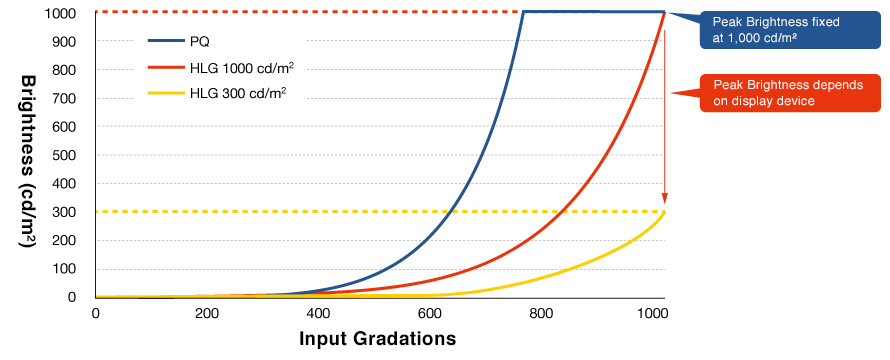Color Management Resources
The Ins and Outs of HDR ― Gamma Curves
 |
 |
 |
 |
BT.2100 — a New International Standard for HDR
In July of 2016, the ITU-R BT.2100 international standard for HDR was established. As a result of this, the standards for content production and transmission have been determined, and it is expected that the adoption of HDR will be further accelerated.
As the table below shows, the five elements introduced on the previous page have clearly been gradually evolving since the establishment of the BT.709 standard for full HD. Though BT.2020 and BT.2100 are substantially very similar, they differ in the dynamic range that can be displayed.
International HDR Standards
|
BT.709 Current Full HD Standard |
BT.2020 4K/8K Standard |
BT.2100 4K/8K HDR Standard |
|
|---|---|---|---|
| Resolution | Full HD | 4K, 8K | HD, 4K, 8K |
| Bit Depth | 8-bit | 10 or 12 bits | 10 or 12 bits |
| Frame Rate | Up to 60p | Up to 120p | Up to 120p |
| Color Gamut | Rec.709 | Rec.2020 | Rec.2020 |
| Brightness (Dynamic Range) | SDR | SDR | HDR |
Visible Difference (image for illustrative purposes) |
|
 SDR |
 HDR |
Two Gamma Curves
In order to properly display HDR images, it's not enough to simply raise the level of brightness — it's crucial to display color and tones in a way that matches human eyesight. Color and tones are affected by an input-output characteristic called gamma that each input and output device has.
The BT.2100 standard provides two gamma curves as standards for different types of production work.
For Internet Streaming and Movies:
PQ (Perceptual quantization)
For Broadcast TV:
HLG (Hybrid Log-Gamma)
The PQ gamma curve is based on the characteristics of human visual perception, and is most suitable for the production of movies or streaming video content on the internet, where reproduction accuracy is key.
On the other hand, the HLG gamma curve is intended to allow for display on existing SDR TVs without looking out-of-place, and is most suitable for broadcast TV and live video feeds.
Advantages of the PQ and HLG Gamma Curves for HDR
| PQ (Perceptual Quantization) | HLG (Hybrid Log-Gamma) | ||
|---|---|---|---|
| Target | Internet video streaming, movies | Broadcast TV, live video | |
| Advantages |
|
|
|
| Peak Brightness |
Absolute value of 1,000 cd/m² Consistent, regardless of display device |
Relative value Varies by display device |
|
| Black Level | 0.005 cd/m2 or lower | 0.005 cd/m2 or lower | |
| Proposed by | Dolby | BBC & NHK | |
| Reference Standards | SMPTE ST 2084、ITU-R BT.2100 | ITU-R BT.2100 | |
| Reference Standards | SMPTE ST 2084 & ITU-R BT.2100 | Outstanding | Good |
| Appearance on SDR TVs | Poor | Fair | |
| Live Broadcasts | Fair | Outstanding | |
The graph below shows both the PQ and HLG gamma curves for HDR.
The peak brightness of PQ gamma curve is fixed at 1,000 cd/m² (or higher). To put it another way, the gamma curve is always the same, with an upper limit of 1,000 cd/m², regardless of the peak brightness of the display device, allowing for consistent image reproduction.
On the other hand, the HLG gamma curve's peak brightness is whatever the peak brightness of the display device is. In other words, because the gamma curve varies depending on the peak brightness of the display device, it allows for acceptable viewing of HDR content even on existing SDR displays, with less image degradation.
Comparison of PQ and HLG Gamma Curves for HDR |
 |
 |
 |
 |
 |





